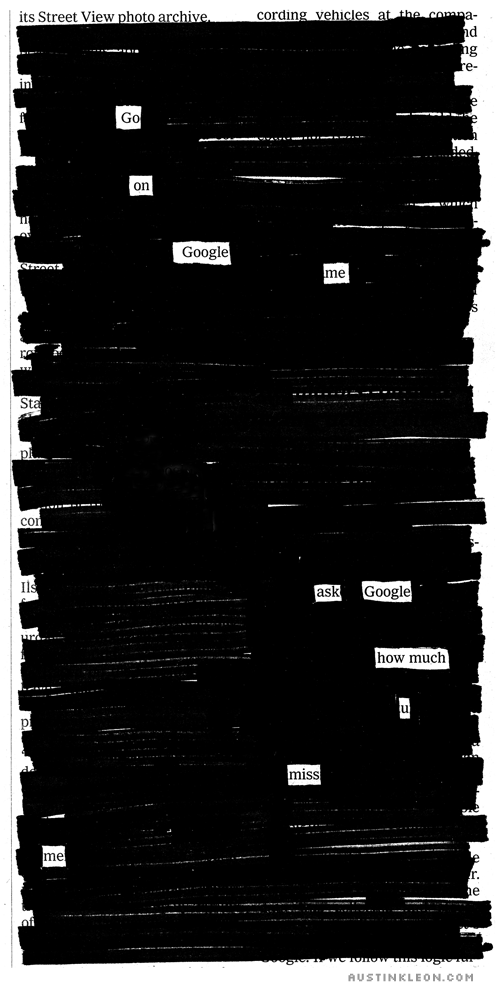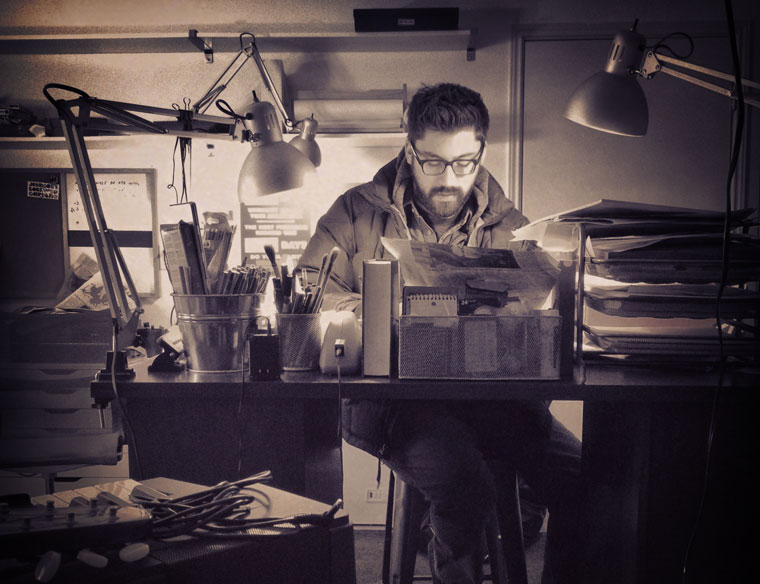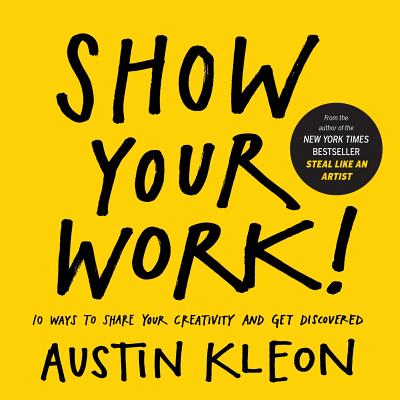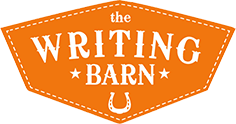by Gardiner Brown
A couple of weeks ago, while perusing Book People (greatest local book store in the state of Texas), I came across a book of blackout poems: Newspaper Blackout by Austin Kleon. Now, the blackout poem is a form of poetry wherein the writer takes an already written text (like a newspaper) and uses a Sharpie to eliminate the words they don’t want to make an entirely new piece of writing. This makes the blackout poem particularly interesting in that it is, at its best, both a verbal and a visual form. This form has only entered my own creative consciousness in the last year, so I’ve been working under the assumption that the blackout poem was a relatively new form, but in looking at Austin Kleon’s book I found that it had a much longer history than I had imagined. He dates its use back all the way to the mid-eighteenth century.
While looking at Austin Kleon’s book, a Book People employee came by, noticed what I was reading, and told me he would be speaking at the store the next week and that he was a local author. Unfortunately, I couldn’t make the event, but I was able to send Austin a set of questions about his thoughts on blackout poetry, writing, and his own work that I thought might interest our readers. In emailing him, I found that Austin was an extremely polite, thoughtful, and overall delightful person to communicate with!
Austin’s own blackout poems are precise in their lyricism, playful, and surprisingly modern. Where modern elements in poetry are often jarring to me as a reader, Austin’s choice to use newspaper as his medium makes these elements feel perfectly natural.

In his work, Kleon brings together elements which are both youthful and aged in their post-modern self-awareness, grimly concerned with the shape of our world and able to celebrate the smallest things within it. Every poem in Newspaper Blackout was a complete pleasure to read.
Writing Barn: Why newspaper? I know that there is history to the newspaper blackout as a medium, but what is the message or the motive for you behind making the news your medium? How do you see this as related to your work?
Austin Kleon: As they used to say, “Today’s newspaper is tomorrow’s fish wrapping.” I like the idea of taking something that’s not supposed to last and turning it into something that does. I like the transformation — taking the news, which is ephemeral, and turning it into poetry, which is supposed to be timeless.
WB: Your latest book, Show Your Work!, is all about getting your creative work out into the real world. I have always assumed that blackout poems would be particularly hard to “get out there” or publish through a larger press. This obviously hasn’t been the case for you. What was your experience with publishing “Newspaper Blackout”? Where did you hit walls in the process? Were publishers resistant to this medium? What suggestions do you have for young poets looking to get their black out poems out there?
AK: I never worried about publishing my poems through a traditional press. I just posted them to my blog, and eventually, a big publisher came to me. My advice to all young people is the same: do good work and share it with people. Put it where people can see it.
WB: In your timeline of the blackout poem, you mention poets like Jen Bervin and Janet Holmes who have taken the works of other famous writers, in this case William Shakespeare and Emily Dickinson, and made their own blackout poems of them. What are your feelings on making blackout poems of other authors’ works? Do you see this as being different from blacking out a newspaper?
AK: I don’t use books because people freak out when you “destroy” books. Nobody cares if you destroy the newspaper. The language of fiction (and of course, poetry) is already poetic. I like the challenge of making the non-poetic (i.e. the business section) poetic.
WB: The blackout poem is obviously a visual as well as verbal medium. What are your favorite things about this interplay in the work?
AK: I’ve always thought that on the internet, images of text travel better than the text itself, so that’s nice. One thing I find annoying about working in a visual and verbal medium is how easily the visual will trump the verbal. I can make a stupid, meaningless blackout, but if it looks cool, or there’s color in it, or a neat design, people will still be drawn to it. It’s very easy to cheat.
WB: What do you do when you “make a mistake” and black out something you might have wanted to keep? Do you go out and buy another paper to start the next draft, or do you accept it as part of the process? Do your blackout poems go through several drafts (I am imagining your home filled with knee-high stacks of Arts and Metro)?

AK: I used to screw up all the time and I had to throw out poems, but now I use an overhead transparency and a dry-erase marker laid over the newspaper before I do any of the blacking out.
WB: How does the landscape of Austin or of Texas as a whole appear in your work?
AK: It used to appear more when I was new to Texas, but I’ve lived here for about seven years now, so it doesn’t pop up quite as much, or at all. Other things on my mind, I guess.
WB: How has your own life and your experiences getting discovered and getting your work out there shaped the advice you give in Show Your Work!?
AK: All the advice I have to give is shaped by my own personal practice. I’m not a “guru” or a “creativity expert.” I’m just a writer.

Austin’s latest book, Show Your Work!, came out earlier this year and is a collection of essays offering advice to young writers on getting their creative work out into the world. If you’re interested, you should definitely head over to Book People to buy a copy! You can also visit Austin at his website, austinkleon.com.
